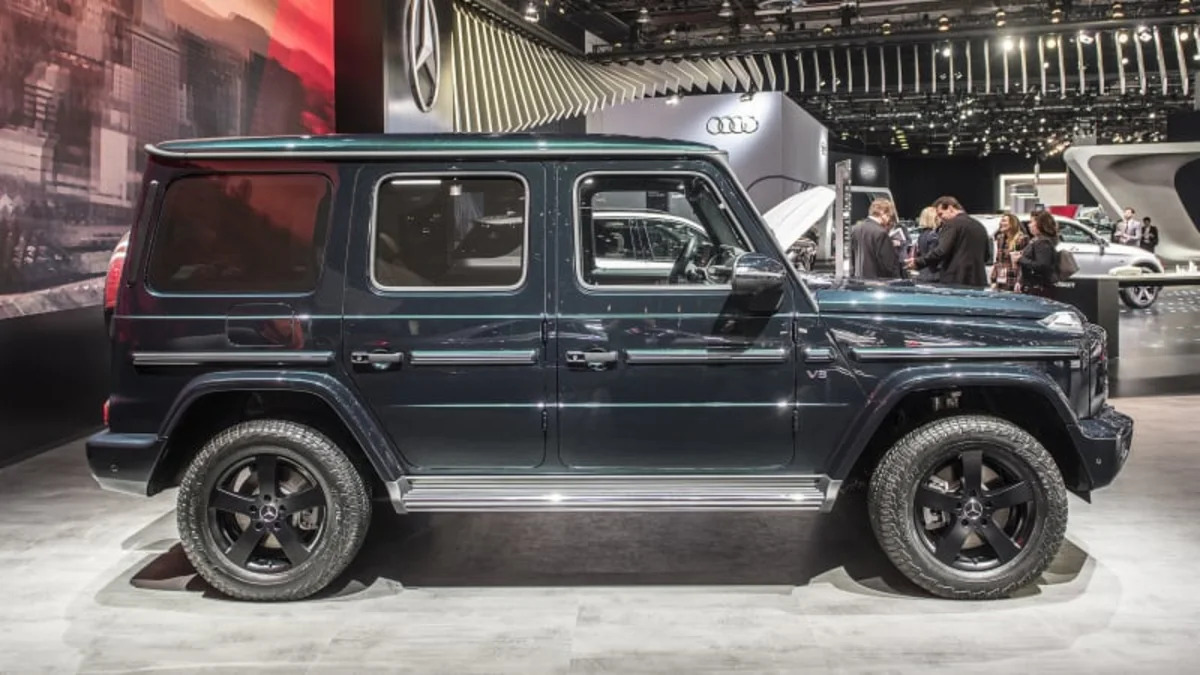When people refer to the Mercedes-Benz Geladenwagen (G-Class) as iconic, they mean it in the original sense of the word. This is not because it is made of wood and painted in gold or other gaudy colors, though that may well be true given its rectilinear design and LA/Miami exterior palette. It is because it has existed in its original form, like the word icon, since approximately the 16th century.
The G-Class is old. If vehicular generations are, like dog ages, roughly equivalent to seven human years, the G-Class is about 280. It was birthed in 1979 as a military transport for the about-to-be-deposed Shah of Iran, and has been updated since. But its design has remained fundamentally unchanged for the past 40 years. It is delightfully anachronistic. A modern, factory-produced restomod.
"The initial idea of the G-Wagen was to bend metal in only two dimensions, which is cheaper and easier to do," says Mercedes/Daimler global design Chief Gorden Wagener. "That wasn't possible. But we had to respect that boxy shape, to honor that and put it in context in this new G-Wagen." He laughs heartily, and thumbs his chest. "The Gorden-Wagen."
It is precisely this brutal and formal angularity and presence that accounts for the G-Wagen's popularity. So much so that, every year for much of this decade, it has set sales records in the U.S. 4,188 G-Wagens were sold to Americans in 2017. That's nearly 1,200 more than the number of SL roadsters the German company sold here. It is one of the most profitable vehicles in the Mercedes-Benz lineup, and one of the ones on which the greatest percentage of consumers choose to select the highly optioned (and pricey) AMG packages—a G65 starts at nearly $223,000. It is an intensely capable off-road war truck that has found a home as a status symbol of haute bourgeois boulevardierism.
The G-Class is old. If vehicular generations are, like dog ages, roughly equivalent to seven human years, the G-Class is about 280. It was birthed in 1979 as a military transport for the about-to-be-deposed Shah of Iran, and has been updated since. But its design has remained fundamentally unchanged for the past 40 years. It is delightfully anachronistic. A modern, factory-produced restomod.
"The initial idea of the G-Wagen was to bend metal in only two dimensions, which is cheaper and easier to do," says Mercedes/Daimler global design Chief Gorden Wagener. "That wasn't possible. But we had to respect that boxy shape, to honor that and put it in context in this new G-Wagen." He laughs heartily, and thumbs his chest. "The Gorden-Wagen."
It is precisely this brutal and formal angularity and presence that accounts for the G-Wagen's popularity. So much so that, every year for much of this decade, it has set sales records in the U.S. 4,188 G-Wagens were sold to Americans in 2017. That's nearly 1,200 more than the number of SL roadsters the German company sold here. It is one of the most profitable vehicles in the Mercedes-Benz lineup, and one of the ones on which the greatest percentage of consumers choose to select the highly optioned (and pricey) AMG packages—a G65 starts at nearly $223,000. It is an intensely capable off-road war truck that has found a home as a status symbol of haute bourgeois boulevardierism.
So Mercedes has to be extremely careful when redesigning such an important nameplate. It cannot risk alienating its loyal consumers, or despoiling the heritage of what is likely the oldest unchanged model on the contemporary market, or ever.
"A car like the SL reflects and represents the beauty ideals of its time, of its decade," Wagener says. "The G is different. It is timeless. So that's a greater design challenge in some ways than a complete makeover. Do you want a 'stylish' G-Wagen? Certainly not."
This means that the changes need to be subtle. But when this happens, the attention to detail must be very high in order to maintain a balance between evolution and heritage.
"The whole effect is the result of many, many tiny decisions and details," Wagener says. He proffers an apt metaphor. "We all have two eyes, a nose, and hair. But we all look different."
Of course, there is always the risk that you can mess up an icon. Wagener definitely worried about this. But not too much.
"Design is always the border between genius and disaster," Wagener says. "It's a tough process and you have to give your heart. But we are fortunate at Mercedes-Benz. We never start our day saying, let's make something average. We always want to make history and achieve something. Plus we enjoy ourselves. We have a fabulous job. We are making our toys."
Related Video:






Sign in to post
Please sign in to leave a comment.
Continue